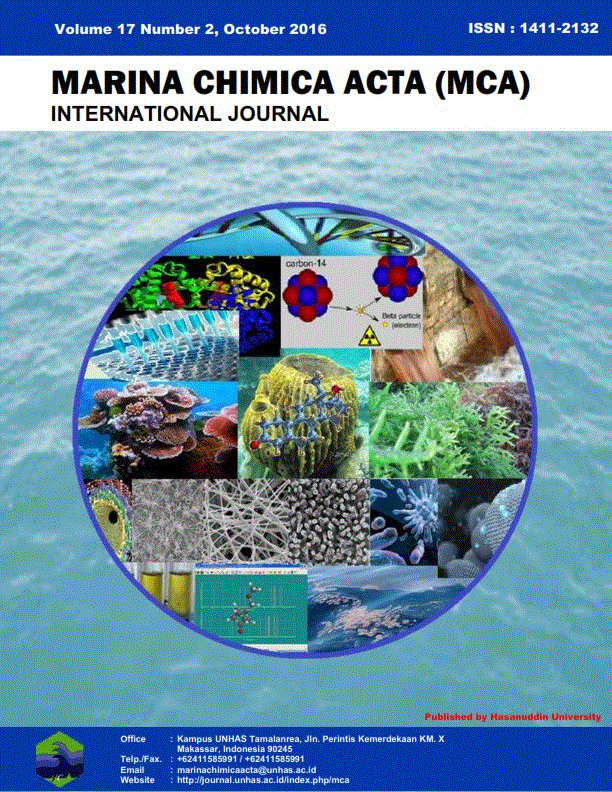UTILIZATION OF HYDROXIDE COMPOUND AS CO2 ABSORBENT FOR MEASUREMENT OF CARBON-14 IN CORAL REEF SAMPLE FROM SPERMONDE ARCHIPELAGO
DOI:
https://doi.org/10.20956/mca.v17i2.1121Abstract
The use of hydroxide compounds as CO2 absorbents for Measurement of Carbon-14 in Coral Reef Sample fromSpermonde Archipelago. This research aimed to determine the age of coral reef sample of Spermonde Archipelago by measuring the activity of carbon-14 using the method Liquid Scintillation Counting (LSC). The coral reef sample was collected in Langkai Island. The research was conducted by following steps of sample preparation, the CO2 absorption using the hydroxide solutions (KOH and NaOH). The measurement of the carbon-14 activities was performed using the Liquid Scintillation Counter (LSC) Hidex 300 SL. The research results indicated that the absorption capacities of KOH and NaOH were 0,450 and 0,425 mol CO2/mol hydroxide respectively. The specific activity of coral reef sample using absorbent KOH and NaOH were 14.51; and 14.57 DPM/g C, respectively.The age of coral reef sample, which was calculated based on the specific activity values using the absorbents KOH and NaOH were 436.13; and 403.61years, respectively.Downloads
References
Adkins, J.F., Griffin, S., Kashgaria, M., Cheng, H., Druffel, E.R.M., Boyoyle, E.A., Edwards, R.L., Shen, C.C. (2002) Radiocarbon Dating of Deep-Sea Corals. Radiocarbon. 44 (2) : 567-580.
Canducci, C., Bartolomei, P., Magnani, G., Rizzo, A. (2013) Upgrade of the CO2 Direct Absorption Method for Low Level 14C Liquid Scintillation Counting. Radiocarbon. 55 (2-3): 260-267.
Faurescu, I., Varlam, C., Stefanescu, I., Cuna, S., Vagner, I., Faurescu, D., Bogdan, D. (2010) Direct Absorption Method and Liquid Scintillation Counting For Radiocarbon Measurements in Organic Carbon from Sediments. Radiocarbon. 52 (2-3): 794–799.
Libby, W.F.(1960) Radiocarbon Dating. Nobel Lecture. Elsevier Publishing Company: Amsterdam.
Maming, Noor, A., Zakir, M., Raya, I., Jauhari, Kartika, S.A. (2014) Aplication in Liquid Scintillation Method om Carbon Dating in Determination of Coral Ages from Spermonde Archipelagos. Marine Chimica Acta. 15 (1): 31-35.
Rositasari, R., 1998, Aspek Ekologi dan Sejarah Pembentukan Terumbu Karang, Balitbang Oseanografi, Puslitbang Oseanologi-LIPI, Jakarta, 13 (3, 4): 1-9.
Satrio and Abidin, Z (2007) Perbandingan Metode Sintesis Benzena Dan Absorpsi CO2 Untuk Penanggalan Radioisotop 14C . Jurnal Ilmiah Aplikasi Isotop Dan Radiasi. 3 (1): 1-34.
Varlam, C, Stefanescu, I., Varlam, M., Popescu, I., Faurescu, I., 2007, Applying the Direct Absorption Method And LSC For 14C Concentration Measurement In Aqueous Samples, Radiocarbon, 49(2), 281-289
Varlam, C., Stefanescu, I., Cuna, S., Vagner, I., Faurescu, I., Faurescu, D. (2010) Radiocarbon and Tritium Levels along the Romanian Lower Danube River. Radiocarbon. 52, (2–3): 783–793.
Yuliati, H., Akhadi, M. (2005) Radionuklida Kosmogenik Untuk Penanggalan. Puslitbang Keselamatan Radiasi dan Biomedika Nuklir. Pusat radiasiBatan

